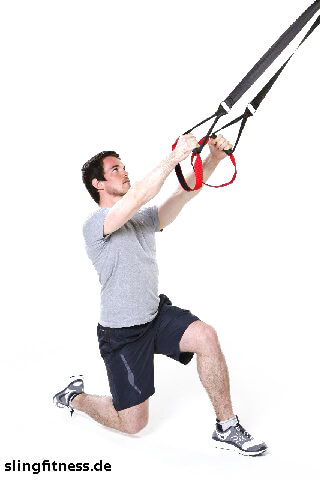Primary: Legs, Glutes (quadrizeps, ischiocrurale M., iliopsoas, soleus, gastrocnemius)
Secondary: Back, Arms (latissimus, erector spinae, bizeps brachii, palmarflexoren)
The one-legged squat requires a good stability and balance of the supporting leg. By lowering the buttocks backwards the knee joint (patella) is relieved and the muscles get specifically trained. In this variation of the one-legged squat, the swinging leg is placed backward. The gluteal muscles get specifically trained by the knee hub.
The following figures illustrate the exercise Squat One-Legged with Straight Knee-Hub:
 |
 |
| Suspension Training Leg Exercises | |
|
Starting Position The arms are stretched and the back is upright or lightly flexed forward. The weight is on the heel of the supporting leg. The back leg is lowered far backwards. The knee of the swinging leg points downwards to the bottom and is strongly flexed. |
Final Position In the final position the body stands on one leg and the upper body is lightly bent backward. The supporting leg is lightly flexed. The arms are stretched and the VarioSling is under tension. One leg is lifted up to 90 degree, gets flexed until its knee is on hip level. |
|
Movement 1 The body is moved down backwards by the flexion of the supporting leg. Simultaneously the swinging leg is flexed and lowered backwards. |
Movement 2 Then the body is raised up again by the power of the supporting leg. The supporting leg is stretched in the hip and the knee joint. Simultaneously the free knee is raised up to hip level. |
|
Hint: The weight has to be shifted completely on the heel of the supporting leg. The more you pull the knee upwards, the higher is the tension in the great gluteal muscles and hip flexor. |
|
